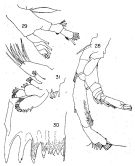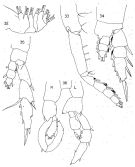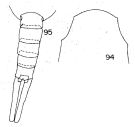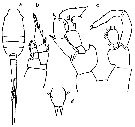|
|
 |
Fiche d'espèce de Copépode |
|
|
Calanoida ( Ordre ) |
|
|
|
Lucicutiidae ( Famille ) |
|
|
|
Lucicutia ( Genre ) |
|
|
| |
Lucicutia maxima Steuer, 1904 (F,M) | |
| | | | | | | Syn.: | Lucicutia grandis : Grice & Hülsemann, 1965 (p.224); no L. maxima : A. Scott, 1909 (p.127, figs.M); Wolfenden, 1911 (p.318); Sars, 1925 (p.211, figs. F); Sewell, 1932 (p.295, figs.M); Rose, 1933 a (part., p.193, Rem.F, figs. F); ? Gunther & Hardy, 1935 (1936) (p.179, Rem.); Tanaka, 1963 (p.49, figs.M); De Decker & Mombeck, 1964 (p.13); Tanaka & Omori, 1967 (p.240) | | | | Ref.: | | | Steuer, 1904 (p.596, Descr.F, fig.F, non M); Wolfenden, 1905 a (p.22, Rem.); ? Farran, 1908 b (p.61, Rem.); Sewell, 1932 (p.295, figs.F, no M); Rose, 1933 a (p.194, Rem.M, fig.M); Hülsemann, 1966 (p.729, figs.F,M, Rem.); Bradford-Grieve & al., 1999 (p.883, 945, figs.F,M); Boxshall & Halsey, 2004 (p.132: F; p.133: M; p.131: figs.F,M); Vives & Shmeleva, 2007 (p.342, figs.F,M, Rem.) |  issued from : K. Hülsemann in Bull. Mar. Sc., 1966, 16 (4). [p.710, Figs.28-31]. Female: 28, A2; 29, Md (mandibular palp); 30, Md (biting edge); 31, Mx1.
|
 issued from : K. Hülsemann in Bull. Mar. Sc., 1966, 16 (4). [p.712, Figs.32-36]. Female: 32, Mx2; 33, Mxp; 34, P1; 35, P5. Male: 36, P5.
|
 issued from : K. Hülsemann in Bull. Mar. Sc., 1966, 16 (4). [p.716, Figs.55-58]. Female: head (dorsal); 56, idem (lateral); 57, urosome (dorsal); 58, idem (lateral right side). Nota: Spine-like protrusions on anterior of head smaller, directed downward. All females examined had a large anal flap (not shown by Steuer), anal segment swollen. Furca shorter than abdomen.
|
 issued from : K. Hülsemann in Bull. Mar. Sc., 1966, 16 (4). [p.722, Figs.94-95]. Male: 94, head (dorsal); 95, urosome (dorsal). Nota: Head with two small pointed protrusions on each side. Abdomen and furca one and one-half times contained in cephalothorax.. length of furca 2/3 of abdomen; furcal rami about 7 times longer than wide. Anal segment slightly shorter than preceding segment. Right A1 exceeding end of furca by 2 segments. 2nd basipodal segment of P1 with tube-like protrusion; endopod of P1 3-segmented. 2nd basipodal segment of right P5 straight with minute teeth on inner margin; 2 nd basipodal segment of left P5 protruded on distal inner corner with small teeth.
|
 issued from : A. Steuer in Zool. Anz., 1904, 27 (19. [p.596, Fig.4]. Female: last thoracic segment and urosome (lateral).
|
 issued from : R. Stephen, 2007 : Data sheets of NIO, Kochi, India (on line). Female (from Indian Ocean): a, habitus (dorsal); b, P1; d, rostrum. Male: c, P5.
|
 Lucicutia maxima Lucicutia maxima female: 1 - Characters following not combined : Prosome about 3 times longer than urosome. Cephalosome with slightly projecting and rounded anterior corners and well developed lateral spinous projections; anal somite about as long as wide; caudal rami 11.7 times longer than wide and bowed outwards at base, leaving elliptical space between rami proximally. 2 - P1 with 3-segmented endopod. 3 - Cephalosome with 2 pairs of spinous projections (1 anterolateral and 1 lateral). 4 - Anterolateral projections small, directed ventrally. Lateral margins of anal somite convex. Caudal rami shorter than urosome.
|
 Lucicutia maxima Lucicutia maxima male: 1 - P1 with 3-segmented endopod. 2 - Cephalosome with 2 pairs of spinous projections (1 anterolateral and 1 lateral). 3 - Anterolateral projections small; lateral projections directed ventrally. 4 - Anal somite slightly shorter than preceding somite; caudal rami about 7 times longer than wide.
| | | | | Ref. compl.: | | | Grice, 1963 a (p.496); Grice & Hulsemann, 1967 (p.18); 1968 (tab.2); Vinogradov, 1968 (1970) (p.277); Björnberg, 1973 (p.344, 387); Frontier, 1977 a (p.15); Madhupratap & Haridas, 1990 (p.310, fig.3, vertical distribution night/day; fig.7: cluster); Shih & Young, 1995 (p.70); Suarez-Morales & Gasca, 1998 a (p.110); Fernandes, 2008 (p.465, Tabl.2); Salah S. & al., 2012 (p.155, Tableau 1); El Arraj & al., 2017 (p.272, table 2, seasonal composition); | | | | NZ: | 7 + 1 douteuse | | |
|
Carte de distribution de Lucicutia maxima par zones géographiques
|
| | | | | | | | | | | |  Issued from : M. Madhupratap & P. Haridas in J. Plankton Res., 12 (2). [p.310, Fig.3]. Issued from : M. Madhupratap & P. Haridas in J. Plankton Res., 12 (2). [p.310, Fig.3].
Vertical distribution of calanoid copepod (mean +1 SE), abundance No/100 m3. 12- Lucicutia maxima.
Night: shaded, day: unshaded.
Samples collected from 6 stations located off Cochin (India), SE Arabian Sea, November 1983, with a Multiple Closing Plankton Net (mesh aperture 300 µm), in vertical hauls at 4 depth intervalls (0-200, 200-400, 400-600, 600-1000 m). |
| | | | Loc: | | | ? Antarct., sub-Antarct., off E Canary Is., off Morovccan Atlantic Coast, Cap Ghir (Morocco), G. of Mexico, Bermuda, ? Lisbon, ? Ireland, Madagascar (Nosy Bé), W Indian, Bay of Bengal, Andaman Sea, China Seas (South China Sea), SE Pacif., off Juan Fernandez Is., N-S Chile (also sub-Antarct.) | | | | N: | 20 | | | | Lg.: | | | (21) F: 9,3-7,8; M: 7,8-7,7; (1034) F: 8,7; (1068) M: 7,4; {F: 7,80-9,30; M: 7,70-7,80}
| | | | Rem.: | Bathypélagique.
Du fait des synonymies certaines répartitions géographiques sont à confirmer.
Voir aussi les remarques en anglais | | | Dernière mise à jour : 24/10/2022 | |
|
|
 Toute utilisation de ce site pour une publication sera mentionnée avec la référence suivante : Toute utilisation de ce site pour une publication sera mentionnée avec la référence suivante :
Razouls C., Desreumaux N., Kouwenberg J. et de Bovée F., 2005-2025. - Biodiversité des Copépodes planctoniques marins (morphologie, répartition géographique et données biologiques). Sorbonne Université, CNRS. Disponible sur http://copepodes.obs-banyuls.fr [Accédé le 27 décembre 2025] © copyright 2005-2025 Sorbonne Université, CNRS
|
|
 |
 |










